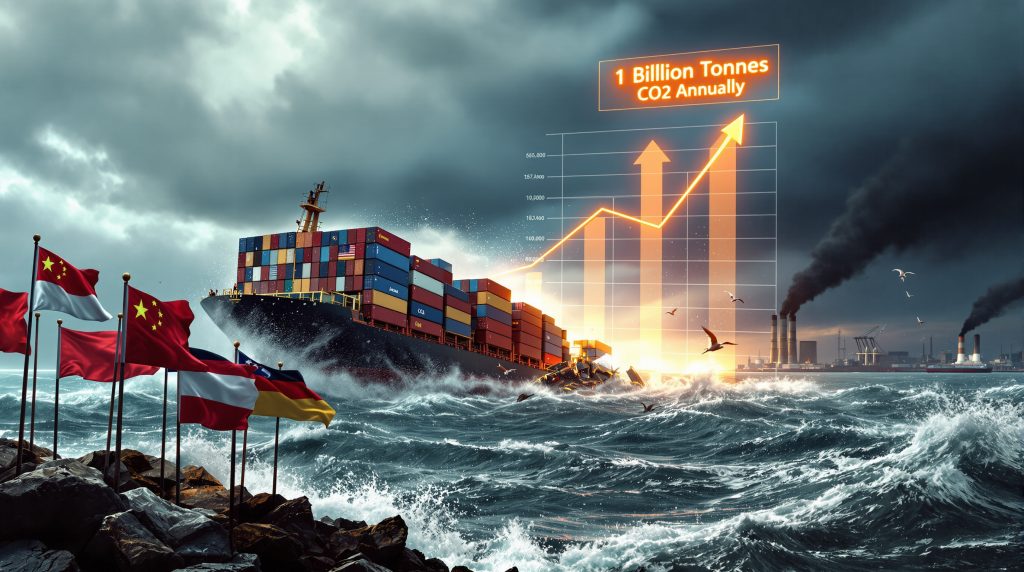The global shipping emissions deal collapse represents one of the most significant setbacks in international climate diplomacy this decade. After years of painstaking negotiations involving 175 member nations through the International Maritime Organization (IMO), what seemed like a breakthrough agreement to decarbonise the world's shipping fleet fell apart at the final moment.
The proposed framework would have established the maritime industry's first binding carbon reduction targets, potentially transforming how goods move across the world's oceans. However, fundamental disagreements over economic sovereignty, implementation timelines, and financial responsibilities ultimately derailed the ambitious climate initiative.
Understanding the Maritime Emissions Challenge
The shipping sector serves as the backbone of global trade, carrying over 90% of international commerce while generating approximately 1 billion tonnes of CO2 annually. This massive carbon footprint equals the emissions of an entire developed nation, making maritime transport a critical component in global climate efforts.
Current industry statistics reveal the scale of the challenge:
- Daily emissions: Ships produce roughly 2.7 million tonnes of CO2 every 24 hours
- Fleet composition: More than 100,000 commercial vessels operate worldwide
- Fuel consumption: The industry burns approximately 300 million tonnes of heavy fuel oil annually
- Growth projections: Maritime trade volumes are expected to increase 130% by 2050
Without intervention, shipping emissions could increase by 250% by 2050 as global trade expands, undermining international climate commitments under the Paris Agreement.
The proposed IMO framework aimed to address this escalating challenge through mandatory emission reduction targets of 20% by 2030 and 70% by 2040, coupled with implementation of global fuel standards and carbon pricing mechanisms.
The Framework That Never Was
The collapsed agreement represented years of diplomatic work to establish comprehensive climate rules for international shipping. Key components of the proposed framework included:
Emission Reduction Targets:
- Mandatory 20% reduction by 2030 compared to baseline levels
- Aggressive 70% reduction target by 2040
- Long-term goal of net-zero emissions by 2050
Implementation Mechanisms:
- Global fuel standard for cleaner marine fuels
- Carbon pricing system for international shipping routes
- Enhanced monitoring and reporting requirements
- Technology transfer programs for developing nations
Financial Structures:
- Industry-funded decarbonisation investments
- Climate finance mechanisms for emerging economies
- Penalty systems for non-compliance
- Incentive programs for early adopters
Economic Sovereignty Concerns Drive Opposition
Major maritime nations withdrew support citing concerns about competitive disadvantage and regulatory overreach. Countries with significant shipping industries argued that uniform carbon pricing would disproportionately impact their maritime sectors while potentially driving business to non-compliant competitors.
Primary opposition arguments included:
- Fear of increased operational costs being passed to consumers
- Concerns about regulatory sovereignty over national shipping companies
- Disputes over revenue distribution from carbon pricing mechanisms
- Disagreements on mandatory technology transfer obligations
- Worries about enforcement mechanisms in international waters
Several influential maritime powers expressed reservations about the framework's economic implications, particularly regarding impacts on port competitiveness and shipping route economics. Furthermore, these concerns were exacerbated by broader oil price dynamics that could affect fuel cost calculations.
The Developing Nations Divide
A fundamental split emerged between industrialised nations pushing for immediate implementation and developing countries seeking more gradual approaches with enhanced financial support.
| Negotiation Position | Developed Nations | Developing Nations | Small Island States |
|---|---|---|---|
| Implementation Timeline | Immediate start | 15-year phase-in | Emergency measures |
| Funding Mechanism | Industry-led financing | International climate funds | Dedicated adaptation support |
| Technology Access | Market-driven solutions | Mandatory tech transfer | Priority green technology access |
| Enforcement Approach | Strict penalty system | Capacity-building focus | Enhanced monitoring protocols |
Developing nations argued that immediate implementation would unfairly burden their emerging maritime industries while developed countries had decades to establish competitive advantages. Small island developing states, facing existential threats from sea-level rise, pushed for the most aggressive timelines but lacked negotiating power against larger maritime economies.
Technical Implementation Roadblocks
Beyond political disagreements, practical challenges around monitoring and enforcement across diverse maritime jurisdictions contributed to the collapse. The complexity of tracking emissions from vessels crossing multiple territorial waters and operating under various flag state regulations created implementation hurdles.
Key technical challenges included:
- Establishing consistent monitoring systems across different maritime jurisdictions
- Creating enforceable standards for vessels operating in international waters
- Developing verification processes for alternative fuel technologies
- Integrating reporting requirements with existing maritime safety protocols
Industry representatives highlighted concerns about supply chain disruptions and increased consumer costs, intensifying lobbying efforts in the final negotiation weeks. Moreover, the technical complexity of implementing renewable energy transformations across diverse maritime operations posed additional challenges.
Regional Alternatives Emerge
With global coordination stalled, various regional initiatives are gaining momentum as alternatives to comprehensive IMO action.
European Maritime Green Corridors are being developed to connect major EU ports with zero-emission shipping routes, potentially creating competitive advantages for compliant vessels while pressuring others to upgrade.
Pacific Island Coalition members are exploring creation of their own emission standards, particularly for vessels entering their exclusive economic zones. These small island developing states view regional action as essential given their vulnerability to climate impacts.
Arctic Shipping Protocols are under development to address the unique environmental sensitivities of polar shipping routes as ice coverage diminishes and maritime traffic increases.
Mediterranean Clean Shipping Zones represent another regional approach, with countries around the Mediterranean Sea considering coordinated carbon pricing and fuel standards for vessels operating in these waters.
Supply Chain and Economic Implications
The global shipping emissions deal collapse creates immediate uncertainty for companies planning long-term investments in cleaner maritime technologies and alternative fuels.
Investment Impact Analysis:
- Delayed capital deployment: Over $50 billion in planned green shipping investments now face uncertainty
- Route optimisation concerns: Companies may avoid regions implementing unilateral emission standards
- Insurance premium increases: Maritime insurance costs likely to rise due to regulatory uncertainty
- Consumer cost pressures: Potential for increased shipping expenses to flow through to end users
Without global coordination, the maritime industry faces navigating multiple, potentially conflicting regulatory frameworks as individual nations and regions implement their own standards. This uncertainty particularly affects battery metals investment plans, as raw materials shipping costs become increasingly difficult to predict.
Climate Impact of the Negotiation Failure
The shipping sector's inability to establish binding global standards significantly jeopardises broader international climate commitments and goals.
Projected Climate Consequences:
- Temperature impact: Could contribute an additional 0.1°C to global warming by 2100
- Carbon budget consumption: Uses 15-20 billion tonnes of remaining global carbon budget
- Ocean acidification acceleration: Continued high emissions worsen marine ecosystem damage
- Sea-level rise: Delayed action increases coastal community vulnerability
The regulatory uncertainty may also influence climate policy development in other transportation sectors, including aviation and trucking, as industries observe the challenges of establishing global emission standards. Consequently, companies are increasingly looking toward proven sustainability transformation strategies from other sectors.
Unilateral Policy Options for Individual Nations
Despite the global agreement collapse, individual countries retain significant policy tools to address shipping emissions within their jurisdictions.
Available National Measures:
- Port State Control: Enhanced inspections and penalties for high-emission vessels entering territorial waters
- Fuel Quality Standards: Requirements for cleaner marine fuels when operating in national waters
- Carbon Border Adjustments: Tariffs on goods transported via high-emission shipping methods
- Green Shipping Incentives: Tax benefits and subsidies for clean maritime technology adoption
Several nations are already implementing or considering these unilateral approaches, potentially creating a complex patchwork of regional standards that could ultimately pressure the industry toward cleaner operations. In addition, the European Union's proposed carbon border adjustment mechanism will likely extend to maritime transport in future phases.
Private Sector Initiatives Gain Momentum
Major shipping companies and cargo owners are forming voluntary coalitions to establish private sector emission standards and develop green shipping corridors independent of government action.
These industry-led initiatives focus on:
- Creating voluntary emission reduction commitments
- Developing alternative fuel supply chains
- Establishing green shipping route certifications
- Implementing cargo owner sustainability requirements
Technology innovation is accelerating as private sector and national governments increase investment in alternative fuel research to maintain competitive advantages in an increasingly environmentally conscious market. However, these private initiatives still require consideration of the broader decarbonisation benefits to maintain investor confidence and public support.
Future Negotiation Prospects
The IMO is expected to reconvene discussions within 18 months, potentially with modified proposals addressing the concerns that led to the current impasse.
Potential compromise elements for future negotiations:
- Differentiated timelines based on economic development levels and maritime industry maturity
- Enhanced financial mechanisms specifically designed to support developing nation participation
- Voluntary initial phases with mandatory targets beginning around 2035
- Technology-neutral approaches allowing multiple decarbonisation pathways rather than prescriptive solutions
Success in future negotiations will require addressing the diverse economic concerns that derailed current talks while maintaining the environmental ambition necessary for meaningful climate impact.
Building Consensus Through Demonstration
Small-scale pilot programs could help build confidence in emission reduction technologies and create momentum for renewed global negotiations. These demonstration projects would allow testing of:
- Alternative fuel logistics and supply chain development
- Carbon pricing mechanisms in limited geographic areas
- Technology transfer programs between developed and developing nations
- Monitoring and verification systems for emission reductions
Successful pilot programs could provide practical evidence to address scepticism and technical concerns that contributed to the negotiation collapse. Furthermore, organisations like the International Energy Agency continue to provide technical guidance and best practices for maritime decarbonisation efforts.
Preparing for Future Climate Diplomacy
Future maritime climate negotiations will require enhanced coordination between governments, industry, environmental organisations, and international bodies to address the complex web of concerns that derailed current discussions.
Critical success factors include:
- Comprehensive economic impact assessments analysing costs and benefits for different nation categories
- Clear technology roadmaps showing practical pathways for achieving emission targets with available and emerging technologies
- Innovative financial mechanisms addressing developing nation concerns while ensuring adequate funding for decarbonisation
- Practical enforcement frameworks that respect national sovereignty while ensuring global compliance
The stakes remain high as maritime emissions continue growing while the window for limiting global temperature increases narrows. The global shipping emissions deal collapse represents a significant setback, but the underlying pressure for maritime decarbonisation continues building through consumer demand, investor expectations, and accelerating climate impacts.
The challenge now lies in finding alternative pathways that can achieve meaningful emission reductions while navigating the complex political and economic realities that led to this diplomatic failure. Whether through regional agreements, industry initiatives, or eventually renewed global negotiations, the maritime sector's transformation remains an essential component of global climate action.
Want to Stay Ahead of Maritime Industry Investments?
The collapse of global shipping emissions negotiations creates significant uncertainty for maritime sector investments, but also potential opportunities in clean technology and alternative fuel companies. Discovery Alert's proprietary Discovery IQ model delivers instant notifications on ASX mineral discoveries that could supply critical materials for maritime decarbonisation, helping investors identify emerging opportunities before broader market recognition. Begin your 30-day free trial today to gain actionable insights into the evolving intersection of climate policy and resource investment opportunities.




